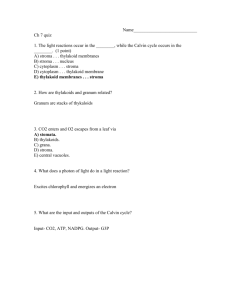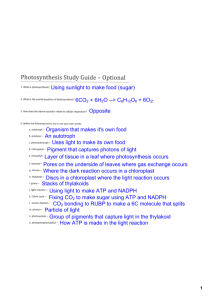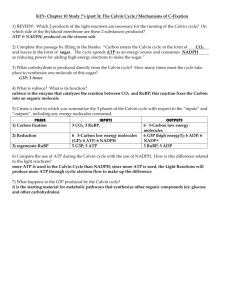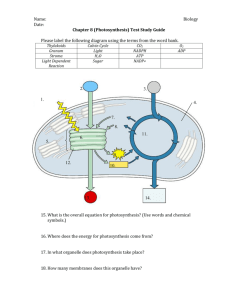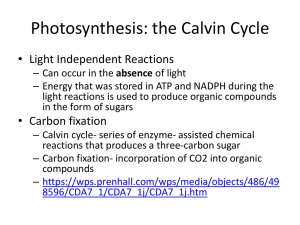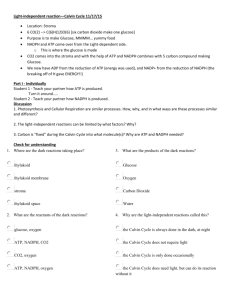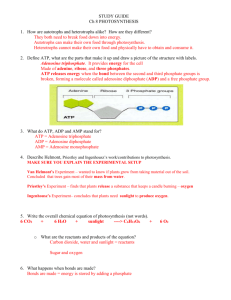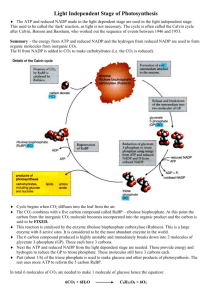Photosynthesis
advertisement
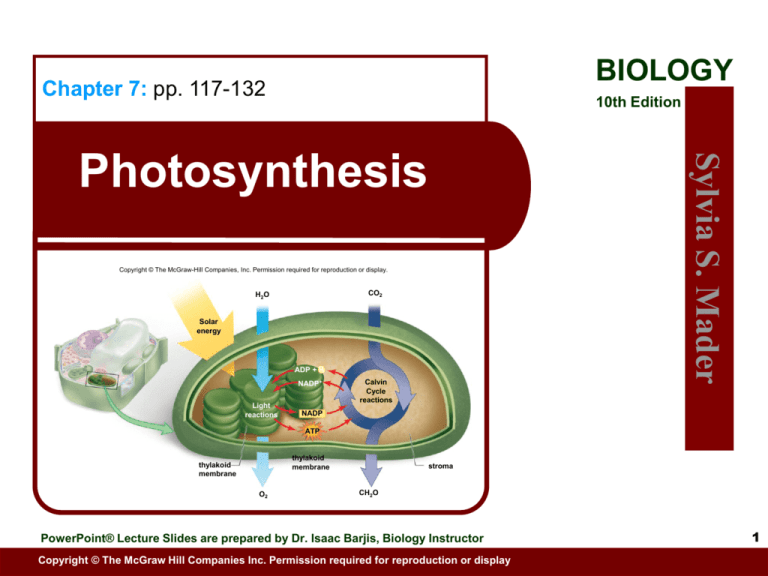
BIOLOGY Chapter 7: pp. 117-132 10th Edition Copyright © The McGraw-Hill Companies, Inc. Permission required for reproduction or display. CO2 H2 O Insert figure 7.4 here NADP+ Solar energy ADP + P NADP+ Light reactions Calvin Cycle reactions Sylvia S. Mader Photosynthesis NADP ATP thylakoid membrane thylakoid membrane O2 stroma CH2O PowerPoint® Lecture Slides are prepared by Dr. Isaac Barjis, Biology Instructor Copyright © The McGraw Hill Companies Inc. Permission required for reproduction or display 1 Outline Photosynthetic Organisms Photosynthetic Process Plants as Solar Energy Converters Photosynthesis Light Reactions Noncyclic Cyclic Calvin Cycle Reactions Fixation of Carbon Dioxide C4 CAM 2 Photosynthetic Organisms All life on Earth depends on a star 93 million miles away (solar energy) Photosynthetic organisms (algae, plants, and cyanobacteria) transform solar energy into carbohydrates Called autotrophs because they produce their own food. Photosynthesis: A process that captures solar energy Transforms solar energy into chemical energy Energy ends up stored in a carbohydrate Photosynthesizers produce all food energy Only 42% of sun’s energy directed towards Earth reaches surface Of this, only 2% is captured by photosynthesizers Of this, only a tiny portion results in biomass 3 Photosynthetic Organisms Copyright © The McGraw-Hill Companies, Inc. Permission required for reproduction or display. mosses trees kelp Euglena garden plants cyanobacteria diatoms (Moss): © Steven P. Lynch; (Trees): © Digital Vision/PunchStock; (Kelp): © Chuck Davis/Stone/Getty Images; (Cyanobacteria): © Sherman Thomas/Visuals Unlimited; (Diatoms): © Ed Reschke/Peter Arnold; (Euglena): © T.E. Adams/Visuals Unlimited; (Sunflower): © Royalty-Free/Corbis 4 Photosynthesis Photosynthesis takes place in the green portions of plants Leaf of flowering plant contains mesophyll tissue Cells containing chloroplasts Specialized to carry on photosynthesis Raw materials for photosynthesis are carbon dioxide and water Roots absorb water that moves up vascular tissue Carbon dioxide enters a leaf through small openings called stomata Diffuses into chloroplasts in mesophyll cells In stroma, CO2 combined with H2O to form C6H12O6 (sugar) Energy supplied by light Chlorophyll and other pigments absorbs solar energy and energize electrons prior to reduction of CO2 to a carbohydrate 5 Leaves and Photosynthesis Copyright © The McGraw-Hill Companies, Inc. Permission required for reproduction or display. cuticle upper epidermis Leaf cross section mesophyll lower epidermis CO2 O2 leaf vein outer membrane stoma inner membrane stroma stroma granum Chloroplast 37,000 thylakoid space thylakoid membrane Grana independent thylakoid in a granum overlapping thylakoid in a granum © Dr. George Chapm an/ Visuals Unlim ited 6 Photosynthetic Pigments Pigments: Chemicals that absorb some colors in rainbow more than others Colors least absorbed reflected/transmitted most Absorption Spectra Pigments found in chlorophyll absorb various portions of visible light Graph showing relative absorption of the various colors of the rainbow Chlorophyll is green because it absorbs much of the reds and blues of white light 7 Photosynthetic Pigments Copyright © The McGraw-Hill Companies, Inc. Permission required for reproduction or display. Increasing wavelength chlorophyll a chlorophyll b carotenoids Gamma rays X rays UV Micro- Radio Infrared waves waves visible light 500 600 Wavelengths (nm) a. The electromagnetic spectrum includes visible light. 750 Relative Absorption Increasing energy 380 500 600 750 Wavelengths (nm) b. Absorption spectrum of photosynthetic pigments. 8 Animation Please note that due to differing operating systems, some animations will not appear until the presentation is viewed in Presentation Mode (Slide Show view). You may see blank slides in the “Normal” or “Slide Sorter” views. All animations will appear after viewing in Presentation Mode and playing each animation. Most animations will require the latest version of the Flash Player, which is available at http://get.adobe.com/flashplayer. 9 Photosynthesis Releases Oxygen Copyright © The McGraw-Hill Companies, Inc. Permission required for reproduction or display. © B. Runk/ S. Schoenberger/ Grant H eilm an Photography 10 Photosynthetic Reactions: Two Sets of Reaction Light Reaction – takes place only in the presence of light They are the energy-capturing reactions Chlorophyll absorbs solar energy This energizes electrons Electrons move down electron transport chain Pumps H+ into thylakoids Used to make ATP out of ADP and NADPH out of NADP Calvin Cycle Reaction takes place in stroma CO2 is reduced to a carbohydrate Use ATP and NADPH produced carbohydrate They are synthetic reactions 11 Photosynthesis Overview Copyright © The McGraw-Hill Companies, Inc. Permission required for reproduction or display. CO2 H2O Solar energy ADP + P NADP+ Light reactions Calvin Cycle reactions NADP ATP stroma thylakoid membrane O2 CH2O 12 Photosynthetic Reactions: The Light Reactions Light reactions consist of two alternate electron pathways: Noncyclic electron pathway Cyclic electron pathway Capture light energy with photosystems Pigment complex helps collect solar energy like an antenna Occur in the thylakoid membranes Both pathways produce ATP The noncyclic pathway also produces NADPH 13 Light Reactions: The Noncyclic Electron Pathway Takes place in thylakoid membrane Uses two photosystems, PS-I and PS-II PS II captures light energy Causes an electron to be ejected from the reaction center (chlorophyll a) Electron travels down electron transport chain to PS-I Replaced with an electron from water Which causes H+ to concentrate in thylakoid chambers Which causes ATP production PS-I captures light energy and ejects an electron Transferred permanently to a molecule of NADP+ Causes NADPH production 14 Light Reactions: Noncyclic Electron Pathway Copyright © The McGraw-Hill Companies, Inc. Permission required for reproduction or display. H2O CO2 solar energy ADP+ P NADP+ sun Light reactions Calvin cycle sun NADPH ATP thylakoid membrane energy level electron acceptor O2 CH2O electron acceptor ee e- e NADP+ H+ NADPH e e- reaction center reaction center pigment complex pigment complex Photosystem I e- Photosystem II CO2 H2 O CH2O Calvin cycle reactions 2H+ 1 2 O2 15 Animation Please note that due to differing operating systems, some animations will not appear until the presentation is viewed in Presentation Mode (Slide Show view). You may see blank slides in the “Normal” or “Slide Sorter” views. All animations will appear after viewing in Presentation Mode and playing each animation. Most animations will require the latest version of the Flash Player, which is available at http://get.adobe.com/flashplayer. Animation Please note that due to differing operating systems, some animations will not appear until the presentation is viewed in Presentation Mode (Slide Show view). You may see blank slides in the “Normal” or “Slide Sorter” views. All animations will appear after viewing in Presentation Mode and playing each animation. Most animations will require the latest version of the Flash Player, which is available at http://get.adobe.com/flashplayer. 17 Light Reactions: The Cyclic Electron Pathway Uses only photosystem I (PS-I) Begins when PS I complex absorbs solar energy Electron ejected from reaction center Travels down electron transport chain Causes H+ to concentrate in thylakoid chambers Which causes ATP production Electron returns to PS-I (cyclic) Pathway only results in ATP production 18 Organization of the Thylakoid Membrane PS II: Electron transport chain: Consists of cytochrome complexes Carries electrons between PS II and PS I Also pump H+ from the stroma into thylakoid space PS I: Consists of a pigment complex and electron-acceptors Adjacent to an enzyme that oxidizes water Oxygen is released as a gas Has a pigment complex and electron acceptors Adjacent to enzyme that reduces NADP+ to NADPH ATP synthase complex: Has a channel for H+ flow Which drives ATP synthase to join ADP and Pi 19 Organization of a Thylakoid Copyright © The McGraw-Hill Companies, Inc. Permission required for reproduction or display. H2O CO2 solar energy P ADP+ NADP+ Light reactions Calvin cycle NADP+ reactions NADPH ATP NADP+ NADP+ thylakoid membrane thylakoid membrane thylakoid thylakoid space stroma CH2O O2 granum photosystem II H+ electron transport chain stroma photosystem I NADP reductase H+ Pq e- NADP+ e- e NADPH eH+ H2O 2 H+ + H+ 1 2O 2 Thylakoid space ATP synthase H+ H+ ATP H+ H+ chemiosmosis P +ADP Stroma 20 Animation Please note that due to differing operating systems, some animations will not appear until the presentation is viewed in Presentation Mode (Slide Show view). You may see blank slides in the “Normal” or “Slide Sorter” views. All animations will appear after viewing in Presentation Mode and playing each animation. Most animations will require the latest version of the Flash Player, which is available at http://get.adobe.com/flashplayer. 21 ATP Production Thylakoid space acts as a reservoir for hydrogen ions (H+) Each time water is oxidized, two H+ remain in the thylakoid space Electrons yield energy Flow of H+ back across thylakoid membrane Used to pump H+ across thylakoid membrane Move from stroma into the thylakoid space Energizes ATP synthase Enzymatically produces ATP from ADP + Pi This method of producing ATP is called chemiosmosis 22 Ecology Focus: Tropical Rain Forests Equatorial; Temp>26ºC; Rainfall>200cm & uniform Most plants woody; many vines and epiphytes; little or no undergrowth Contribute greatly to CO2 uptake, slowing global warming Development has reduced them from 14% to 6% of Earth’s surface Deforestation adds 20-30% of atmospheric CO2, but also removes CO2 sink Increasing temps also reduce productivity 23 Ecology Focus: Global Warming and Tropical Rain Forests Copyright © The McGraw-Hill Companies, Inc. Permission required for reproduction or display. Mean Global Temperature Change (°C) 5.5 maximum likely increase 4.5 3.5 most probable temperature increase for 2 × CO2 2.5 minimum likely increase 1.5 0.5 -0.5 1860 1940 2020 2060 2100 b. Year a. © George Holton/Photo Researchers, Inc. 24 Calvin Cycle Reactions: Overview of C3 Photosynthesis A cyclical series of reactions Utilizes atmospheric carbon dioxide to produce carbohydrates Known as C3 photosynthesis Involves three stages: Carbon dioxide fixation Carbon dioxide reduction RuBP regeneration 25 Calvin Cycle Reactions: Carbon Dioxide Fixation CO2 is attached to 5-carbon RuBP molecule Result in a 6-carbon molecule This splits into two 3-carbon molecules (3PG) Reaction accelerated by RuBP Carboxylase (Rubisco) CO2 now “fixed” because it is part of a carbohydrate 26 The Calvin Cycle: Fixation of CO2 Copyright © The McGraw-Hill Companies, Inc. Permission required for reproduction or display. H2O CO2 solar energy ADP+ Light reactions P Calvin cycle NADPH ATP Metabolites of the Calvin Cycle stroma O2 CH2O 3 CO2 intermediate RuBP ribulose-1,5-bisphosphate 3PG 3-phosphoglycerate BPG 1,3-bisphosphoglycerate G3P glyceraldehyde-3-phosphate 3 C6 3 RuBP C5 6 3PG C CO2 fixation CO2 reduction Calvin cycle 3 ADP + 3 P 6 ATP 3 6 ADP + 6 P regeneration of RuBP These ATP molecules were produced by the light reactions. These ATP and NADPH molecules were produced by the light reactions. 6 BPG C3 3 ATP 5 G3P C 6 NADPH 6 G3P C 3 6 NADPH+ 3 net gain of one G3P Other organic molecules 2 Glucose 27 Calvin Cycle Reactions: Carbon Dioxide Reduction 3PG reduced to BPG BPG then reduced to G3P Utilizes NADPH and some ATP produced in light reactions 28 The Calvin Cycle: Reduction of CO2 Copyright © The McGraw-Hill Companies, Inc. Permission required for reproduction or display. ATP ADP + 3PG BPG NADPH P G3P NADP+ As 3PG becomes G3P, ATP becomes ADP + P and NADPH becomes NADP+ 29 Calvin Cycle Reactions: Regeneration of RuBP RuBP used in CO2 fixation must be replaced Every three turns of Calvin Cycle, Five G3P (a 3-carbon molecule) used To remake three RuBP (a 5-carbon molecule) 5X3=3X5 30 The Calvin Cycle: Regeneration of RuBP Copyright © The McGraw-Hill Companies, Inc. Permission required for reproduction or display. 5 G3P 3 ATP 3 RuBP 3 ADP + P As five molecules of G3P become three molecules of RuBP, three molecules of ATP become three molecules of ADP +P . 31 Importance of Calvin Cycle G3P (glyceraldehyde-3-phosphate) can be converted to many other molecules The hydrocarbon skeleton of G3P can form Fatty acids and glycerol to make plant oils Glucose phosphate (simple sugar) Fructose (which with glucose = sucrose) Starch and cellulose Amino acids 32 Animation Please note that due to differing operating systems, some animations will not appear until the presentation is viewed in Presentation Mode (Slide Show view). You may see blank slides in the “Normal” or “Slide Sorter” views. All animations will appear after viewing in Presentation Mode and playing each animation. Most animations will require the latest version of the Flash Player, which is available at http://get.adobe.com/flashplayer. 33 Animation Please note that due to differing operating systems, some animations will not appear until the presentation is viewed in Presentation Mode (Slide Show view). You may see blank slides in the “Normal” or “Slide Sorter” views. All animations will appear after viewing in Presentation Mode and playing each animation. Most animations will require the latest version of the Flash Player, which is available at http://get.adobe.com/flashplayer. Fate of G3P Copyright © The McGraw-Hill Companies, Inc. Permission required for reproduction or display. G3P glucose phosphate fatty acid synthesis amino acid synthesis10 starch cellulose + fructose phosphate sucrose 35 C4 Photosynthesis In hot, dry climates Stomata must close to avoid wilting CO2 decreases and O2 increases O2 starts combining with RuBP instead of CO2 Photorespiration, a problem solve in C4 plants In C4 plants Fix CO2 to PEP a C3 molecule The result is oxaloacetate, a C4 molecule In hot & dry climates Avoid photorespiration Net productivity about 2-3 times C3 plants In cool, moist, can’t compete with C3 36 Chloroplast Distribution in C4 vs. C3 Plants Copyright © The McGraw-Hill Companies, Inc. Permission required for reproduction or display. C3 Plant C4 Plant mesophyll cells bundle sheath cell vein stoma bundle sheath cell vein stoma 37 CO2 Fixation in C4 vs. C3 Plants Copyright © The McGraw-Hill Companies, Inc. Permission required for reproduction or display. CO 2 RuBP Calvin cycle 3PG G3P mesophyll cell a. CO2 fixation in a C3 plant, blue columbine, Aquilegia caerulea CO 2 mesophyll C4 cell bundle CO sheath 2 cell Calvin cycle G3 b. CO2 fixation in a C4 plant, corn, Zea mays b: © Nigel Cattlin/Photo Researchers, Inc. 38 CAM Photosynthesis Crassulacean-Acid Metabolism CAM plants partition carbon fixation by time During the night CAM plants fix CO2 Forms C4 molecules, Stored in large vacuoles During daylight NADPH and ATP are available Stomata closed for water conservation C4 molecules release CO2 to Calvin cycle 39 CO2 Fixation in a CAM Plant Copyright © The McGraw-Hill Companies, Inc. Permission required for reproduction or display. night CO 2 C4 day CO 2 Calvin cycle G3P CO2 fixation in a CAM plant, pineapple, Ananas comosus © S. Alden/PhotoLink/Getty Images. 40 Animation Please note that due to differing operating systems, some animations will not appear until the presentation is viewed in Presentation Mode (Slide Show view). You may see blank slides in the “Normal” or “Slide Sorter” views. All animations will appear after viewing in Presentation Mode and playing each animation. Most animations will require the latest version of the Flash Player, which is available at http://get.adobe.com/flashplayer. 41 Climatic Adaptation: Photosynthesis Each method of photosynthesis has Advantages and disadvantages Depends on the climate C4 plants most adapted to: High light intensities C3 plants better adapted to High temperatures Limited rainfall Cold (below 25°C) High moisture CAM plants better adapted to extreme aridity CAM occurs in 23 families of flowering plants Also found among nonflowering plants 42 Review Flowering Plants Photosynthetic Pigments Photosynthesis Light Reactions Noncyclic Cyclic Carbon Fixation Calvin Cycle Reactions C4 CAM 43 BIOLOGY Chapter 7: pp. 117-132 10th Edition Copyright © The McGraw-Hill Companies, Inc. Permission required for reproduction or display. CO2 H2 O Insert figure 7.4 here NADP+ Solar energy ADP + P NADP+ Light reactions Calvin Cycle reactions Sylvia S. Mader Photosynthesis NADP ATP thylakoid membrane thylakoid membrane O2 stroma CH2O PowerPoint® Lecture Slides are prepared by Dr. Isaac Barjis, Biology Instructor Copyright © The McGraw Hill Companies Inc. Permission required for reproduction or display 44
